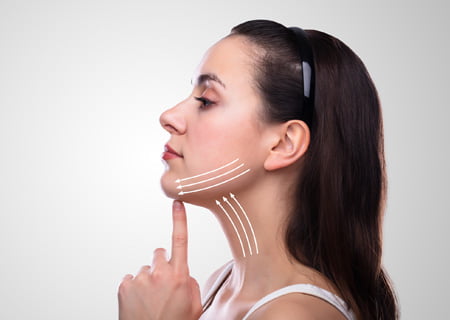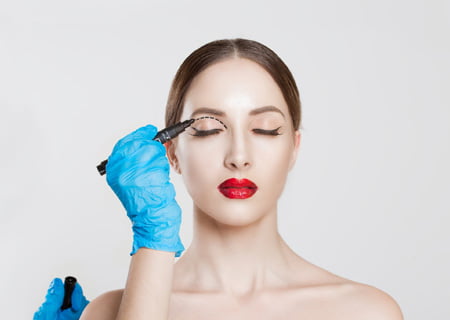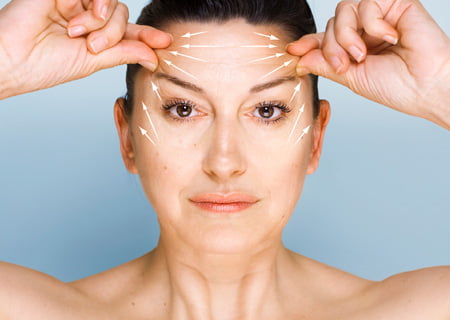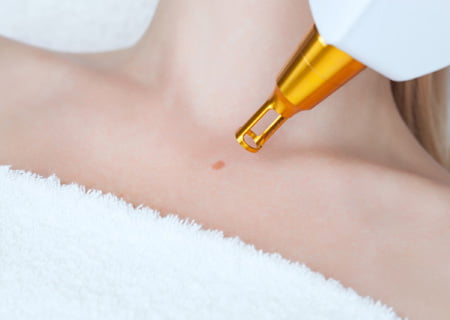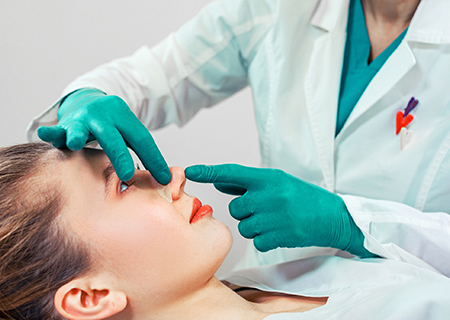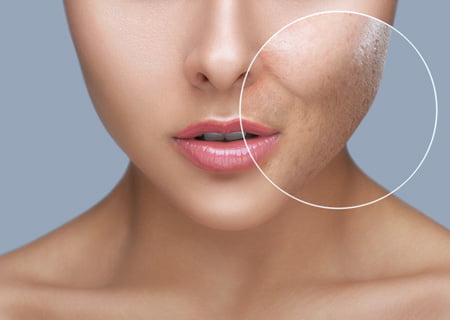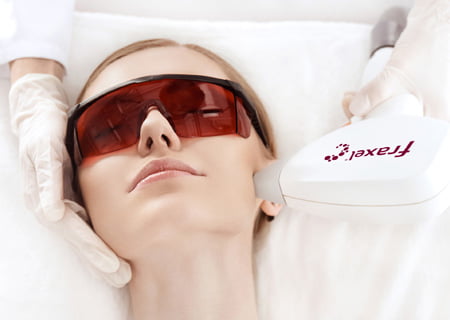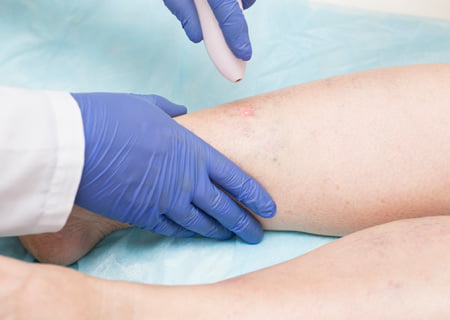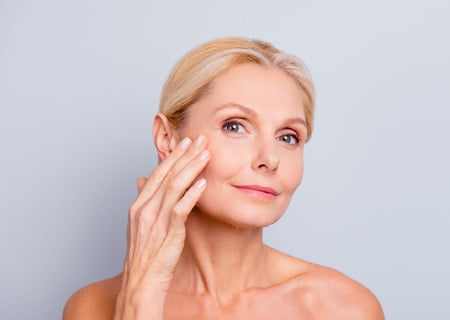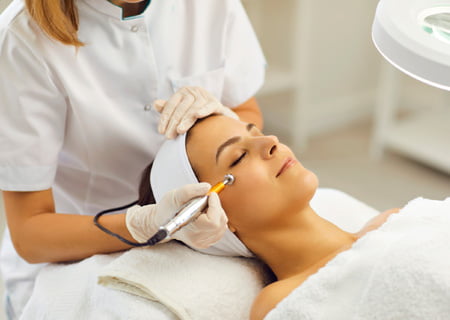Dr. Kristina Zakhary
Otolaryngology-Head and Neck Surgeon
With special focus on Facial Plastic and Reconsctructive Surgery

FAQs
The result of surgery : what to expect ?
The outcome of any surgery depends on two things: the patient and the surgeon.
- Factors related to the patient may affect the final result of the surgery and delay the recovery period. These factors include: thick skin, a tendency toward excessive scar formation, slow recovery, heavy smoking, heavy alcohol intake, obesity, etc.
However, these factors do not contra-indicate surgery. - Factors related to the surgeon include surgical experience and artistic judgment.
What are the risks ?
As with other surgical procedures, cosmetic surgery entails possible complications such as bleeding, infection, excessive scar formation, anesthesia complications and rejection of implants, etc. Fortunately, these complications are uncommon.
What happens before surgery ?
A complete medical examination and a series of laboratory tests are arranged for you before surgery. Professional photographs are also taken. - It is important that you inform our office about any medical problems you may suffer from, such as allergy to any medication, heart disease, psychological disease or any other medical problem. - It is important that you avoid exposure to the sun, smoking, alcohol intake and medications containing aspirin for at least two weeks prior to surgery.
Is there any pain during surgery ?
You experience no pain whatsoever during surgery if you are given general anesthesia. For less major surgeries, local anesthesia can be used, usually with little discomfort.
What happens after surgery ?
You return home the same day or the day following surgery. You may experience mild discomfort, some bleeding, some swelling and some skin discoloration for a few days. Numbness may persist for a few days to a few weeks around the operated area. Patients are usually presentable and can return to work two to three weeks following surgery. Your appearance will continue to improve steadily for six months to a year, due to the gradual resorption of the remaining swelling. Following the removal of all dressings, the patient continues to visit the office for periodic check-ups for two to five years. Any early complications can be detected by examination during the course of these visits.
Questions & Answers
How Can I Reduce the Look of Fine Lines and Wrinkles?
When you look in the mirror and see signs of aging creeping up on your face you'll want to look at solutions. While there are creams, lotions and potions out there promising to make you look 20 years younger, it's more than disappointing to see the final results when they do not work for you. By the time you have tried the famous creams advertised in the fashion magazines and on TV you'll be ready to look at filler treatments that are offered by Facial Plastic Surgeons, Cosmetic Dermatology offices, that can give real results fast. Dr. Zakhary is a Board Certified Surgeon who is specialized in Facial Plastic Surgery, who can offer you these good options in Calgary to reduce the look of your fine lines and wrinkles.
Filler treatments
It has been a long quest to find the perfect filler for facial creases and wrinkles but at long last something has been found that can really work. Restylane®, and Perlane fillers contain hyaluronic acid, which is a sugar that is found naturally in the skin. This filler helps to give skin the volume it needs for optimum contouring and harmony.. Since Restylane® does not contain any animal products, the risk of allergies is extremely low. This filler is extremely safe to use and biocompatable since it presents itself naturally in human tissues.
Contact us now at 403-668-2917 or zakharyclinic@yahoo.com to schedule your consultation with Dr. Zakhary in Calgary. It is definitely possible to reduce the look of the wrinkles and lines that are invading your face. Dr. Zakhary can let you know which treatment would be best for you and what you can realistically expect once it has been completed.
Is the American Board of Facial Plastic and Reconstructive Surgery (ABFPRS) recognized by the American Board of Medical Specialties (ABMS)?
Question:
Is the American Board of Facial Plastic and Reconstructive Surgery (ABFPRS) recognized by the American Board of Medical Specialties (ABMS)? Should I be concerned if my facial plastic surgeon is not board certificated by the American Board of Plastic Surgery, but is however certified by the ABFPRS and the American Board of Otolaryngology and a member of the American Academy of Facial Plastic and Reconstructive Surgery? Is the American Board of Facial Plastic and Reconstructive Surgery a board that requires substantial training involved in order to become ABRPRS board certified?
Answer:
In Canada, there are no Boards. Facial Plastic and Reconstructive Surgery is a recognized Specialty domain of training and examination of the Royal College of Physicians and Surgeons of Canada Specialty of Otolaryngology-Head and Neck Surgery. Neither the Alberta College of Physicians and Surgeons, nor the Royal College of Physicians and Surgeons of Canada presently offer certification in facial plastic surgery. Being a Diplomate of the American Board of Facial Plastic and Reconstructive Surgery signifies the highest level of training and expertise in the field; there is no equivalent in Canada.
The issue about whether the American Board of Facial Plastic and Reconstructive Surgery is recognized by the American Board of Medical Specialties (ABMS) has become moot. In every single state in the U.S. where the issue has been raised, the ABFPRS has been formally recognized by state legislature as ABMS equivalent.
To be perfectly clear about the training and certification pathways for general plastic surgery (general plastic surgeons) versus facial plastic surgery (facial plastic surgeons):
General plastic surgeons typically do 5 years of general (abdominal and other) surgery residency (not plastic surgery) followed by a 2-year fellowship in general plastic surgery. Less common is a 3-year general surgery residency followed by a 3-year fellowship in plastic surgery. Board certification in plastic surgery then requires:
- Board certification in general surgery (an ABMS board)
- Passing the written and oral board exams in plastic surgery
- Submitting a case log of 9 consecutive months of surgical cases, with a minimum of 50 qualifying cases.
To be sure, it is a rigorous and difficult certification process.
Facial Plastic Surgeons typically do 1 year of general surgery, followed by 4 or 5 years of dedicated Head and Neck Surgery residency, followed by 1 year of Facial Plastic Surgery Fellowship. Board certification in facial plastic surgery then requires:
- Board Certification in Otolaryngology-Head and Neck Surgery or plastic surgery (both are ABMS boards)
- Passing the written and oral two day Board exams in Facial Plastic Surgery
- Submitting 2 (Two) consecutive Years of surgical cases with a minimum of 100 qualifying cases per year.
It, too, is as rigorous (more if you include the extra surgical case log requirement) and difficult a certification process.
No one in the world can rightly claim that a Board-Certified Facial Plastic Surgeon is less qualified, less skilled, less educated, or less rigorously scrutinized than a general plastic surgeon when it comes to surgery above the collar bones.
One could make the argument that sub-specialists (facial plastic surgeons) are, on average, more narrowly and deeply skilled in their sub-specialty than generalists.
There are excellent general plastic surgeons who also do wonderful work in the face and neck. Only the jealous or insecure few would mislead you into thinking that they're more qualified than Facial Plastic Surgeons in cosmetic surgery of the face and neck ( above the collar bones).
What is your opinion on using a Board Certified Surgeon in Facial Plastic and Reconstructive Surgery for a Facelift surgery?
Question:
What is your opinion on using a Board Certified Surgeon in Facial Plastic and Reconstructive Surgery for a Facelift surgery?
Answer:
Plastic surgeons and facial plastic surgeons are both trained to perform facelift surgeries. In Alberta, a facial plastic surgeon must identify themselves as an Otolaryngology- Head and Neck Surgeon with a Special Interest in Facial Plastic Surgery. This demonstrates training in two fields: Head and Neck Surgery and Facial Plastic Cosmetic Surgery.
Board certification by the American Board of Facial Plastic Surgery and by the American Board of Plastic Surgery bot have minimum requirements for training, examination and experience in their respective fields. The most important decision when choosing a facelift surgeon is to find someone with good results that you find pleasing and a surgeon whose experience you feel comfortable with.
- Ask to see many of the surgeon's before and after photos.
- A facelift surgery should look natural. It should leave the patient looking refreshed.
- There should be no obvious signs that a patient has had a facelift such as a pulled look, changes in the hairline, or distortion of the ear.
- A well-done facelift is a great operation to help your face and neck look younger.
How Do You Know When It Is Time for a Facial Plastic Surgery?
If you're like most women and men, you have put off making any cosmetic surgery or plastic surgery changes to your face for one reason or another for many years. There are a lot of reasons why you may not have taken the plunge earlier to make wanted or necessary changes, but usually it just boils down to timing. When the timing is right to proceed with cosmetic procedures, you will know it, and feel it and you will be ready to pick up the phone to schedule a consultation with Dr. Zakhary.
Many individuals use a lack of money as an excuse to put off any procedure until a later time. At Dr. Zakhary’s practice in Calgary, however, may people tell Dr. Zakhary that money is not an issue when feel that the right time has approached for them to proceed with facial plastic surgery. In most cases it's only a matter of timing and being ready to take the next step forward.
Some people have said that they could no longer look in the mirror and face themselves. It became a struggle to look at the stranger that was aging with wrinkles in the mirror, and for some women it even became a struggle to put on eye or face makeup. That is how they knew that the time had come for a change. The avoidable had all of a sudden become unavoidable and some issues needed to get addressed right away. Sometimes it is as simple as a skin care plan or mole removal, and sometimes, cosmetic facial plastic surgery options are the answer to your concerns.
For others, the decision just seems to manifest itself one day for no apparent reason. All of a sudden a person can wake up in the morning and decide that the time has come to get Rhinoplasty surgery, an ear tuck (Otoplasty surgery), earlobe repair procedure, or some wrinkle improvement with wrinkle reduction agent or Restylane for the fine lines and wrinkles.
When the timing is right you will be able to pick up the phone and call for an appointment without hesitation. It is a lot easier to confront doing the cosmetic surgery that you've desperately wanted to do on your face once a solid decision has been made. You will know it, feel it and there won't be any regrets after you have hung up the phone and have an appointment with Dr. Zakhary listed on your calendar.
There is no way to say when the timing will be right for you. Maybe it is just something you need to give some thought to. If you've been contemplating getting some changes made to your appearance you will feel confident when it is the right thing to do. It's the moment when you feel like you really deserve to look and feel your best, and can make other things work around taking some special time for you.
It really is all about you, your self-esteem and your goals. Once you can align these things in order and put your priorities in place you'll be able to start the ball rolling by picking up th
Rhinoplasty, more commonly referred to as a nose job, is one of the most commonly sought after cosmetic surgeries...
Rhinoplasty, more commonly referred to as a nose job, is one of the most commonly sought after cosmetic surgeries. Whether it’s to change the original shape of your nose, correct the result of an accident or previous surgery, or to improve your air passages, rhinoplasty can improve your most prominent facial feature.
With its continued growth in popularity, it is important that patients educate themselves on the rhinoplasty procedure, including what it is, reasons why it is used, who is a good candidate, expected results and, as well as the risks involved.
1. What is Rhinoplasty or Nose Reshaping?
Nose reshaping surgery, or rhinoplasty, is a surgery that changes the outer appearance of your nose and should maintain or improve your breathing.
2. Reasons Why Someone Would Want or Need a Nose Job
Usually a rhinoplasty is performed if:
- your nose appears too large for your face
- there is a bump on the nasal bridge when viewed in profile
- your nose seems too wide when viewed from the front
- the nasal tip droops or plunges
- the tip is thickened or enlarged
- your nostrils are excessively flared
- your nose is off-center or crooked
- previous injury has made your nose asymmetrical
It is important that you have a clear idea of how you would like your nose to look and, at the same time, realize that there are limitations to the procedure. Patients with sufficient physical and emotional maturity who undergo rhinoplasty because they want to enhance their self-image are usually very satisfied with their decision.
Dr. Zakhary can provide further information if you have an interest in any of these additional procedures.
3. Age Considerations
Plastic surgeons usually recommend that patients wait until they are at least 17 or 18, and possibly older for boys, before undergoing rhinoplasty. This is because the nose may not be fully developed at a younger age. If you are a teen, your plastic surgeon will want to be certain that you have thought carefully about surgery and that the desire to change your appearance is based on your own feelings rather than those of your parents or friends.
In recent years, Canada has seen an increase in the number of teens seeking plastic surgeries. Although this topic can be controversial, the Today Show recently aired a short segment on legitimate reasons for a young person to seek surgical corrections: What Makes Teens Want Plastic Surgery. http://www.msnbc.msn.com/id/21134540/vp/36096396#48208336
Assuming you are in good health, there is no upper age limit for having your nose reshaped. Rhinoplasty is sometimes performed together with a chin augmentation (implant) or other rejuvenate surgery to correct aging changes of the nose such as a drooping tip.
Sometimes certain breathing problems related to the internal nasal structures can be corrected at the same time as nose reshaping is performed. Dr. Zakhary will be able to help you determine whether these structures should be modified along with reshaping your nose.
4. What kind of results can you expect to receive?
The goal of rhinoplasty is a nose that looks natural and blends harmoniously with your other facial features. There are limitations, however, to what can be altered and this must be understood and discussed between you and your doctor.
Since the healing process is gradual, you should expect to wait up to one year to see the final results of your rhinoplasty. You are likely, however, to begin enjoying your new look within weeks of your surgery.
Occasionally, a touchup may be desired to further improve the results. If this is the case, the additional procedure is usually less extensive than the original operation.
It is important that you have realistic expectations and they should be thoroughly discussed with your surgeon Dr. Zakhary. Although results can be fairly dramatic compared to your original nasal features, it is important to maintain your natural appearance and enhance your overall natural beauty.
Different ethnicities have different shapes and esthetic ideals for the shape of the nose and the face in general. These differences should be respected and celebrated.
5. What are the risks involved?
As with any surgical procedure, there are risks, both cosmetic or non-cosmetic., that you should be aware of. Cosmetic risks include asymmetry, under-correction or over-correction of the area of concern.
Non-cosmetic risks include worsening of breathing. While it is normal to have some difficulty breathing through your nose initially after the surgery, persistent difficulty breathing is a complication. Fortunately, complications after rhinoplasty are uncommon. Please take the time to understand all the risks prior to your surgery.
When considering facial plastic surgeries such as rhinoplasty, take the time to educate yourself and understand the procedure. Check our my blog post on the rhinoplasty process, including pre- and post-operation expectations, the surgical process and important questions to ask your doctor Dr. Zakhary.
6. Maintaining a Relationship with Your Plastic Surgeon
You will return to your Dr. Zakhary's office for follow-up care at prescribed intervals, at which time your progress will be evaluated.
Please remember that the relationship with your plastic surgeon does not end when you leave the operating room. If you have questions or concerns during your recovery, or need additional information at a later time, you should contact your Dr. Zakhary at 403-668-2917 or by email at zakharyclinic@yahoo.com.
Though I religiously wear sunscreen now that I'm in my 30's, I wasn't always so careful in my teens. I've noticed some age spots. Is there anything that can be done about those?
Question: Though I religiously wear sunscreen now that I’m in my 30’s, I wasn’t always so careful in my teens. I’ve noticed some age spots. Is there anything that can be done about those?
Answer: Years of sun worship can severely damage skin. Wrinkles, sun spots, skin discoloration and looseness of the skin are the price we often pay for sun exposure without adequate protection. Fraxel™ Laser Therapy skin rejuvenation is an exciting cosmetic treatment that can noticeably improve the appearance of aged or sun-damaged skin, reduce pore size appearance, smooth fine wrinkles, and reduce the appearance of acne and other scars.
What is Fraxel™ Laser Therapy Skin Rejuvenation?
Resurfacing of the skin is performed using the Fraxel™ laser system - one of the most sophisticated laser systems on the market. Your doctor will first pre treat your skin with medical skin therapy creams, and then apply a grid of tiny scanned pulses of laser energy to your skin during the procedure.
How Does It Work?
The laser creates thousands of microscopic holes in your skin. This causes immediate tightening of the skin and stimulates the growth of new collagen – essential to younger, fresher-looking skin. Fraxel™ Laser Therapy improves the skin’s tone and texture and fights fine lines, and discoloration caused by the sun and acne scars. Excellent results can usually be achieved in a series of two to four 30-minute sessions.
The Fraxel™ Laser is superior to older laser skin resurfacing techniques because the microscopic treated areas are surrounded by healthy skin, causing the treated skin to heal more quickly.
What Can I Expect during the Fraxel™ laser therapy?
Your doctor may use a topical anesthetic during the procedure for increased comfort. After the Fraxel™ Laser Therapy procedure your skin will be red and swollen for approximately 3 days. A cold compress will be applied to alleviate discomfort. Over the next three or four days you may experience some slight peeling, similar to sunburn. Typically the skin returns to its normal appearance in three to four days. The results of your Fraxel™ Laser Therapy can last for years. In cases of severe wrinkling or deep acne scars a series of four to six treatments or combination treatments may be required.
The Benefits of Fraxel™ Laser Therapy
Fraxel™ Laser Therapy laser skin rejuvenation decreases pigmentation and fine lines, improves acne scars, and reduces pore size appearance. You can get beautiful, natural results with Fraxel™ Laser Therapy in a series of 30-minute treatments. Fraxel™ Laser Therapy has minimal downtime compared to traditional CO2 laser which is the gold standard for skin resurfacing.
If your skin has been damaged by overexposure to the sun, acne scars, or environmental factors, Fraxel™ Laser Therapy may be the non-surgical anti-aging solution for you. Contact Dr. Zakhary, a qualified facial cosmetic surgeon, at 403-668-2917./strong> to request a personal consultation to discuss how Fraxel™ Laser Therapy laser skin resurfacing can improve the look and feel of your skin.
Dr. Zakhary, Why do my eyes look so tired, even though I don't feel tired?
Q. Dr. Zakhary, Why do my eyes look so tired, even though I don't feel tired?
Answer. No matter how carefully you manage your health and appearance, some signs of aging still show in the mirror, especially loss of volume. As we age, our faces lose fat, muscle and even bone, leaving our faces hollow and tired looking. Even the eye sockets lose bone and become wider and longer with age!
As the eye sockets lose bone, this reveals the dreaded fat bags under our eyes, or the "hollows" under the eyes, that make us look tired and sad. There is a non invasive and simple solution to this concern and its only thirty minutes away!
Restylane® injectable fillers, made of hyaluronic acid, a sugar that occurs naturally in your body, can be used to smooth out wrinkles, and restore diminished volume. The Restylane® can be placed around the eyes and lower eye socketes to fill depressions in the lower eyelid and cheeks to give a more rested appearance.
Of course, as with any medical procedure, it is important to find the right doctor to perform this procedure for you. Contact us at the office of Dr. Zakhary, Calgary Facial Cosmetic Surgeon, to schedule your initial consultation and learn how to look more rejuvenated soon!
January 2011
Questions to Ask Your Facial Cosmetic Surgeon
Questions to Ask Your Facial Cosmetic Surgeon:
You've taken the steps necessary to find a board certified facial plastic surgeon. Now you're ready for your initial consultation. The following questions will help you get a clearer picture of a doctor's qualifications to perform the surgical procedure on non-surgical treatment you are requesting.
1. How many times have you performed this procedure?
It is important to see how experienced and comfortable your surgeon is with the procedure or surgery you are considering. You only have one face to trust to this doctor. Dr. Zakhary is a specialist in Facial Cosmetic Surgery and focuses Exclusively on the face and neck to give you the best possible results. Dr. Zakhary is a surgeon with a specialty in facial plastic and reconstructive surgery. She is double board certified in Head and Neck Surgery as well Facial Plastic Surgery. She is a member of the American Academy of Facial Plastic Surgery, and a Board Member of the Canadian Academy of Facial Plastic Surgery. She is also certified with the American Board of Facial Plastic Surgery.
2. Who will perform the surgery or administer treatment?
Clarify who will administer your treatment. If someone else will be administering treatment or assisting find out about their qualifications. Dr. Zakhary in fact administers all the surgical and injectable procedures that are offered in her clinic. A qualified and trained laser technician administers the laser treatment under the supervision of Dr. Zakhary.
3. Where will you perform the procedure?
Some treatments and cosmetic surgeries can be performed in a doctor's office or outpatient facility. Others are performed at a hospital. Discuss the options available with your doctor. Dr. Zakhary performs her surgeries at the fully credited Riverview surgical Center. The Riverview surgical center is a private and relaxing environment with the newest and most innovative medical equipment
4. Do you have hospital privileges to perform this surgery?
Operating privileges in an accredited hospital demonstrate the hospital administration's confidence in your doctor's ability to perform the surgery you're seeking. Dr. Zakhary has operating privileges at the major Calgary Hospitals including: Peter Lougheed Center, Foothills Medical Center and Rockyview General Hospital, as well as the Riverview Surgical Center.
5. What complications are possible with this treatment?
No matter how safe a surgical or non-surgical treatment is there are always some risks or possible side effects. Find out what the risks are and how your doctor would deal with them if they do happen.
6. What is the expected recovery time for this treatment?
Discuss preoperative restrictions, postoperative instructions, and the steps you must take to ensure the best final results. Dr. Zakhary will take the time during your consultation to discuss this with you and then you will receive a comprehensive pamphlet outlining these details in your Pre-operation appointment as well.
7. How much will treatment cost?
Cosmetic surgery is considered elective surgery and usually will not be covered by insurance. Get a clear picture of all the costs involved. Most doctors require payment in advance. Get clarification on costs before proceeding with your surgery or cosmetic procedure.
8. What if I'm unhappy with the results?
The initial consultation is the time to address all your concerns about your proposed procedure. Discuss your doctor's policy on revisions which are sometimes needed to achieve the desired result. There may be fees associated with revision surgery, and Dr. Zakhary will clarify this with you in your initial consultation.
9. Request to see before and after photos of patients who received this treatment with your doctor.
Ask to see photos of patients that have received the treatment or surgery you're requesting. Verify that the photos are actual patients of the perspective doctor not stock photos or pictures provided by product manufacturer. Dr. Zakhary is very careful to show only authentic before and after photographs of her patients who have given their permission to show these pictures.
Are you currently considering facial plastic surgery or a non-surgical anti-aging technique? Contact my office today to schedule a one-on-one personal and private consultation. Together we will select a technique that will make you look more youthful, refreshed — and completely natural.
What is a Facial Plastic Surgeon? And What is the difference between a General plastic surgeon and a Facial Plastic Surgeon?
Q. What is a Facial Plastic Surgeon? And What is the difference between a General plastic surgeon and a Facial Plastic Surgeon?
A.
Facial Cosmetic Surgery is a big decision as it is, so we wanted to make it easier for you to decide who to choose to trust your face with, by giving you good clear information.
All facial plastic surgeons are physicians who have undergone many years of education and training including university and medical school. After 20 years of education the physician applies for a "residency" in a particular subject. A "resident" is a licensed physician who is pursuing further post-graduate training after receiving a doctor's degree from medical school.
Most Facial Plastic Surgeons do their residency training in Otolaryngology-Head-and-Neck Surgery.
Such residents have succeeded in a very competitive and selective process. Most come from the upper 25% of their medical school class. Then residency begins with one to two years of general surgical training. After that, the resident begins specialty training in Otolaryngology-Head-and-Neck Surgery, which lasts 4 to 6 years. Dr. Zakhary finished medical school and a 5 year post graduate residency training at the esteemed McGill University, under the training of Dr. Nabil Fanous, a prominent Montreal Facial Plastic Surgery expert.
In the Otolaryngology-Head and Neck Surgery residency, the physician studies anatomy, physiology, illness and surgical treatment for head and neck specifically.
After completing that residency, the surgeon then sits for the two-day certification examination in the specialty of Otolaryngology-Head-and-Neck Surgery. If the surgeon passed that examination, the surgeon becomes 'board certified' or “Royal College certified” in Otolaryngology-Head and Neck Surgery. The examination and residency studies focus on Function as well as Appearance.
Some surgeons, like Dr. Zakhary, with special interest in Facial Plastic and Reconstructive Surgery then compete for one of the coveted facial plastic and reconstructive surgery Fellowships. This is a full-year program offering a unique opportunity to study with one of the AAFPRS's master surgeons. Dr. Zakhary completed her fellowship at the prestigious University of Toronto, under the tutelage of Dr. David Ellis.
Many facial plastic surgeons go still further and sit for a second two-day board examination given by the American Board of Facial Plastic and Reconstructive Surgery. That certifying board requires not only successful completion of the examination, but also peer review of surgeries performed by the applicant. Only surgeons previously certified by the American Board of Plastic Surgery and/or the American Board of Otolaryngology may be certified by the American Board of Facial Plastic and Reconstructive Surgery. Dr. Zakhary has passed this certification examination and has met the criteria to be American Board of Facial Plastic and Reconstructive Surgery certified.
You only have one face so it is crucial to choose the correct physician for your Facial Plastic Surgery. Dr. Kristina Zakhary is an expert in plastic surgery of the face. Trust your face to an Expert!
Am I A Good Candidate for Plastic Surgery?
Q&A April 2011
Am I A Good Candidate for Plastic Surgery?
This is an excellent question any potential patient should ask themselves. In fact, the main reason to have a consultation with a facial plastic surgeon is to answer this very question. The truth is, some people are good candidates for plastic surgery, while others are not as good. Here are three main criteria that a patient should have to be a good candidate for plastic surgery:
Realistic Expectations
If you have realistic expectations going into a procedure, then you will have better chance of good results after facial plastic surgery or procedure. It is also important to understand that every procedure has risks and complications, such as bruising and swelling, and you are a good candidate if you can tolerate these risks and complications if they happen. Facial plastic surgery and other minimally-invasive cosmetic procedures can help you look your best, and you will be in a better position to have a good experience if you are realistic in your expectations.
Healthy Lifestyle
A good candidate for plastic surgery is in overall good physical and psychological health. Serious health problems such as heart disease, uncontrolled high blood pressure, or lung disease, obesity, or depression, as well as certain lifestyle choices like smoking or drinking excessively, will increase the rate of complications like bruising, bleeding, infections, healing problems. It is best to consult an accredited facial plastic surgery specialist to review your options.
Willing and Able to Follow the Doctor's Orders
During your initial consultation your doctor will likely go over a list of requirements that you must meet prior to surgery, as well as a list of instructions that should be carefully followed after surgery in order to have the best results and experience. For example, many facial plastic surgery specialists will require patients to quit blood thinner medications, or smoking several weeks prior to scheduled procedure or surgery to reduce the risk of bruising or bad healing.
Assess your lifestyle and willpower. Be honest with your doctor. If you follow the doctor's guidelines, then you are a good candidate for facial plastic surgery and will have a better experience and result.
Still wondering whether you'd make a good candidate for facial plastic surgery or a non-surgical treatment like Restylane®? Call 403-668-2917 today to schedule an initial consultation with Dr. Zakhary.
I've had a mole on my cheek since I was young and I would like to get it removed. Do I need to take time off for this procedure?
Q&A Sept. 2011
Question:
"I've had a mole on my cheek since I was young and I would like to get it removed. I am a bit worried if the procedure will hurt or if I will have bad scaring. Do I need to take time off for this procedure?"
Answer:
Mole removal is a small procedure that can be performed for medical or cosmetic reasons by a trained facial cosmetic surgeon.
Many people refer to a mole as any dark spot or irregularity in the skin. Doctors use different terms such as: birthmarks, abnormal collections of blood vessels (hemangiomas), keratoses (benign or precancerous spots, which appear after about age 30 years). Skin marks such as these are not treated the same way moles.
Moles are small, dark pigmented growths that can appear anywhere on the skin, singularly or in groups. They are usually brown or black in color due to the high concentrations of pigment in the cells that make up the mole, but they can also be skin colour. They appear during childhood, in early adulthood, and can appear even later in life. Sun exposure seems to play a role in the development of moles and can also play a role in the development of atypical, or dysplastic, moles. Heredity is not a big factor in mole development. If your mole has changed in colour, shape, symmetry, border or sensation over time, then it is important to have it investigated to rule out skin cancer.
Mole removal procedure can be completed in 30-45 minutes with local anaesthetic to the area so you will not feel any discomfort. They can be removed by two surgical methods: 1. Excision (cutting) followed by stitches and 2. Excision with cauterization (a tool is used to burn away the mole). Although laser removal has been tried for moles, it is not usually the method of choice for most deep moles because the laser light doesn't penetrate deeply enough.
Typically your facial plastic surgery specialist may choose excision with or without stitches, depending on the depth of the mole and the type of cosmetic outcome desired. If the mole is surgically cut out then you will have sutures put in place and removed after one week. For the day leading up to your procedure, and for the first 48 hours after your mole removal, you will be advised to avoid exercise, and blood thinners in order to minimize your risk of bleeding and swelling.
One of the most common trade-offs after mole removal is a scar. Many people will attempt to remove moles for cosmetic reasons, not realizing that each and every removal may result in a scar. Most often the scar is small and will be expertly placed so that it is less noticeable than the original mole. Many times your facial cosmetic surgeon can give you an idea of the type and location of a scar after mole removal before you make your decision about removal.
Risks of mole removal methods vary from infection, to anesthetic allergy and scarring. It is always prudent to choose a trained facial cosmetic surgeon with appropriate skills and experience with these removals. This will decrease your risk associated with this procedure. Dr. Kristina Zakhary, M.D. FRCSC, specializing in Facial Plastic Surgery, is double board certified in Head and Neck Surgery as well Facial Plastic Surgery. She is prepared to give you a great result.
For more information please call 403-668-2917 or email zakharyclinic@yahoo.com.
What are Six Things I Should Know About Laser Hair Removal?
Q. What are Six Things I Should Know About Laser Hair Removal?
A.
Yes! Laser hair removal is great, but it's not a "one-and-done" treatment. Here are 6 things you should know before getting laser hair removal:
- It may take 6-7 treatments or more to remove most of the hair.
- Treatment with a hair removal laser results in a reduction of the hair follicles, but it may not completely remove all of the hair. This is due to the fact that hair follicles go through growth cycles, and they may not be growing at every hair laser removal treatment. In fact, hair follicles may arise in treated areas up to a year later. Check with your Calgary plastic surgery specialist, Dr. Zakhary, to see what the options and charges are in case this happens.
- Many areas can be treated. The main areas that you can treat include the face, underarms, forearms, bikini lines, and back.
- Men and women can both be treated.
- The cost is very reasonable. Discounts are usually applied when you purchase a package instead of individual treatments.
- Look at the qualifications of the person performing your laser hair removal. Complications such as redness, infection, and pain can occur, so make sure you will be taken care of in case anything happens. Rest assured that Dr. Zakhary’s technician is fully trained and qualified, and Dr. Zakhary herself is always available if any complications occur in her clinic.
All in all, laser hair removal should be a smooth process for you! Call 403-668-2917.nbsp;to schedule an initial consultation with American Board of Facial Plastic Surgery-certified surgeon, Dr. Zakhary, to discuss laser hair removal options for a smooth, hair free skin!
My ear lobes are starting to stretch and I am looking to have them repaired
Q. My ear lobes are starting to stretch and I am looking to have them repaired.
What procedure fixes stretched and torn ear lobes? Can you please explain this procedure more in detail?
A.
Then newest wave in cosmetic procedures is Earlobe Repair and Rejuvenation. Earlobe repair can help refresh earlobes that have been lengthened due to aging or heavy jewelry. With a simple cosmetic procedure such as earlobe repair you can achieve and restore a balanced and refreshed look that is in harmony with the rest of your facial features.
The earlobe is a delicate part of the face which becomes quite noticeable when it is stretched or torn. If your ear lobes are stretched or hanging lower that they did when you were younger this is a result of aging or wearing heaving earrings. Just as our faces begin to age, so do our earlobes. Over time, earlobes, just like the face, lose elasticity and volume which can lead to deflation, elongation, sagging, creases and an over-all appearance of looking old.
Jewelry enhances our everyday look, but years of wearing heavy earrings can cause damage to earlobe over time. Heavy earrings can create a constant pull on the ear, and trauma from an earring being pulled can also result in a split or deformity of the ear lobe. Earlobe Stretching is also very popular with young adults and may be fine for the school or the alternative scene, but does not do well in most corporate or professional settings. When the disks are removed the skin of the earlobe will tighten but not completely and leave the earlobe looking too big and too long for the rest of the head and ear. This requires re-designing and shortening the earlobe to take it back to its pre-stretching size. Luckily this also can be an easy in office procedure.
Earlobe repair and rejuvenation can be an easy in office procedure with little to no down time. Preparations for these procedures are minimal. It takes from 1 1/2 – 2 hours depending on the situation and whether one or both ears are involved. If a patient is a good candidate for the procedure, a topical and local anaesthetic is applied. Torn or stretched earlobes cannot just be sutured shut without removing a thin layer of the skin. For torn earlobes, after the thin layer of the skin is removed, and the edges are closed together, a special technique is used to help the earlobe to remain rounded and natural looking, and avoid an indentation where the scar lays. After 6 to 8 the earlobes can be re-pierced. The finished result is a rejuvenated earlobe that is restored back to its ideal length and shape.
It is very important to choose the correct facial cosmetic surgeon to perform these intricate procedures as these surgeons have the training and skill required to provide you with the best education, information and best possible results with this surgery. Dr. Zakhary is a trained and experienced facial surgeon who is qualified to expertly perform earlobe repair and rejuvenation procedures to help you to look and feel your best. To schedule your consultation or procedure appointment with Dr. Zakhary, facial cosmetic surgeon, feel welcome to call 403-668-2917.

